This blog was written by John Peaveler, VWB/VSF's International Companion Animal & Humanitarian Response Specialist, during his recent trip to Ukraine.
Prologue: I’m lying on the upper bunk of a four-berth sleeper car traveling northward from the coastal city of Odessa, Ukraine, to the Polish city of Pryzmysl just over the border. It’s a fourteen-hour overnight journey through the mountains, and it’s currently the fastest way to travel across the country. All air travel has, of course, been grounded due the ongoing war. The train is hot and crowded and everyone waits impatiently for the sun to set so we can get some relief. Fortunately, there are young children in the next two rooms. They are happy, well-behaved, and bring joy to most of us as they play games up and down the passageway. They are truly a wonderful distraction from the journey and their innocence is a beautiful juxtaposition to the war. Dinner consists of fresh raspberries and hand-pies sold train-side at an evening stop. I think it’s a great time to nap, think, and reflect on the last couple of weeks spent touring the Veterinarians Without Borders (VWB-VSF Canada) programs around the country on this, my fourth such trip since the beginning of the full-scale invasion.
June 23rd, 2023, Mykolaiv Oblast, Southern Ukraine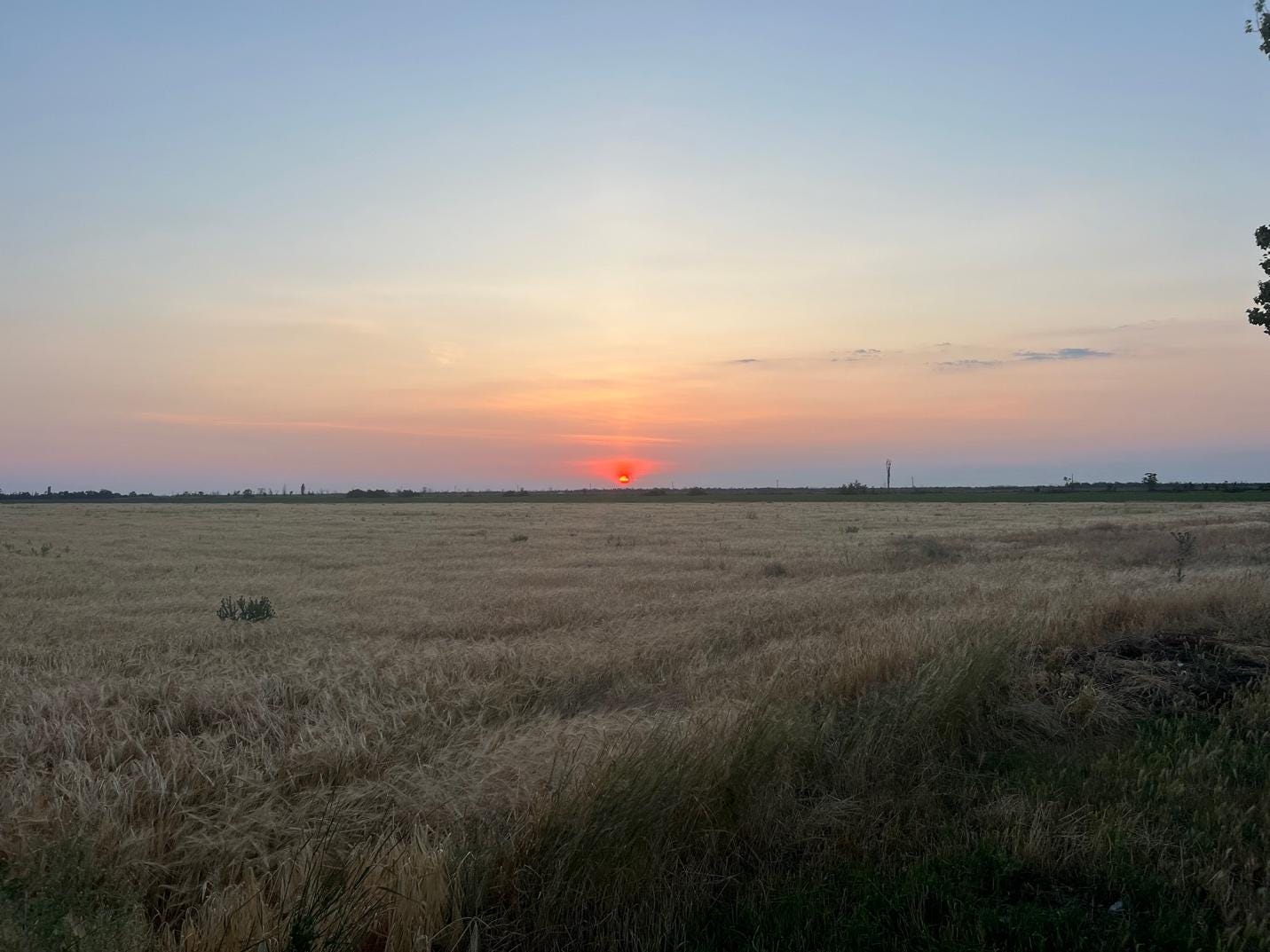
Kate and I stop to appreciate the sunset.
We stop for a minute and get out of the car to take a photo of the setting sun. The image can’t do the scene justice, but it’s still a sunset worth remembering, a beautiful little moment in time. The world seems so full of life in every direction, a heart-warming contrast from my last visit in February, and the sky is an incredible azure blue. Several times as we’ve driven around the region, we’ve passed fields of grain about to be harvested or in the process of being harvested, and it takes no imagination at all to see the Ukrainian flag everywhere, blue over gold, apropos of everything this country is and can become.
We visit a few villages on this segment of our assessment trip, but this evening we’ve just left the small village of Partyzans’ke, which sits about 40 minutes south of Mykolyiav city. It’s a typical bucolic, sparse, post-soviet village, built from a master plan with everything allocated just so. No more or less than an agrarian village could possibly need. A careful network of roads, identical plots of land, cars and tractors dating back to the 60s and 70s. It would simply be a beautiful and fascinating place, except that for about nine months in 2022 this village sat just about square in the centre of the line of contact between the invading Russian and the defending Ukrainian armies. The results are painfully obvious, from the abandoned fighting positions on either side of the village to the rocket fins embedded in the access road. The bridge over the train tracks on the approach to the road has been destroyed and a gravel road has been temporarily built over the tracks. Most of the houses are so damaged they will need to be entirely rebuilt. All require some type of repair. I don’t have a chance to confirm this, but I wouldn’t be surprised if not a single window in the village survived 9 months of artillery, mortar, rocket and missile attack, much less the constant exchange of direct fire from cannons and machine guns.
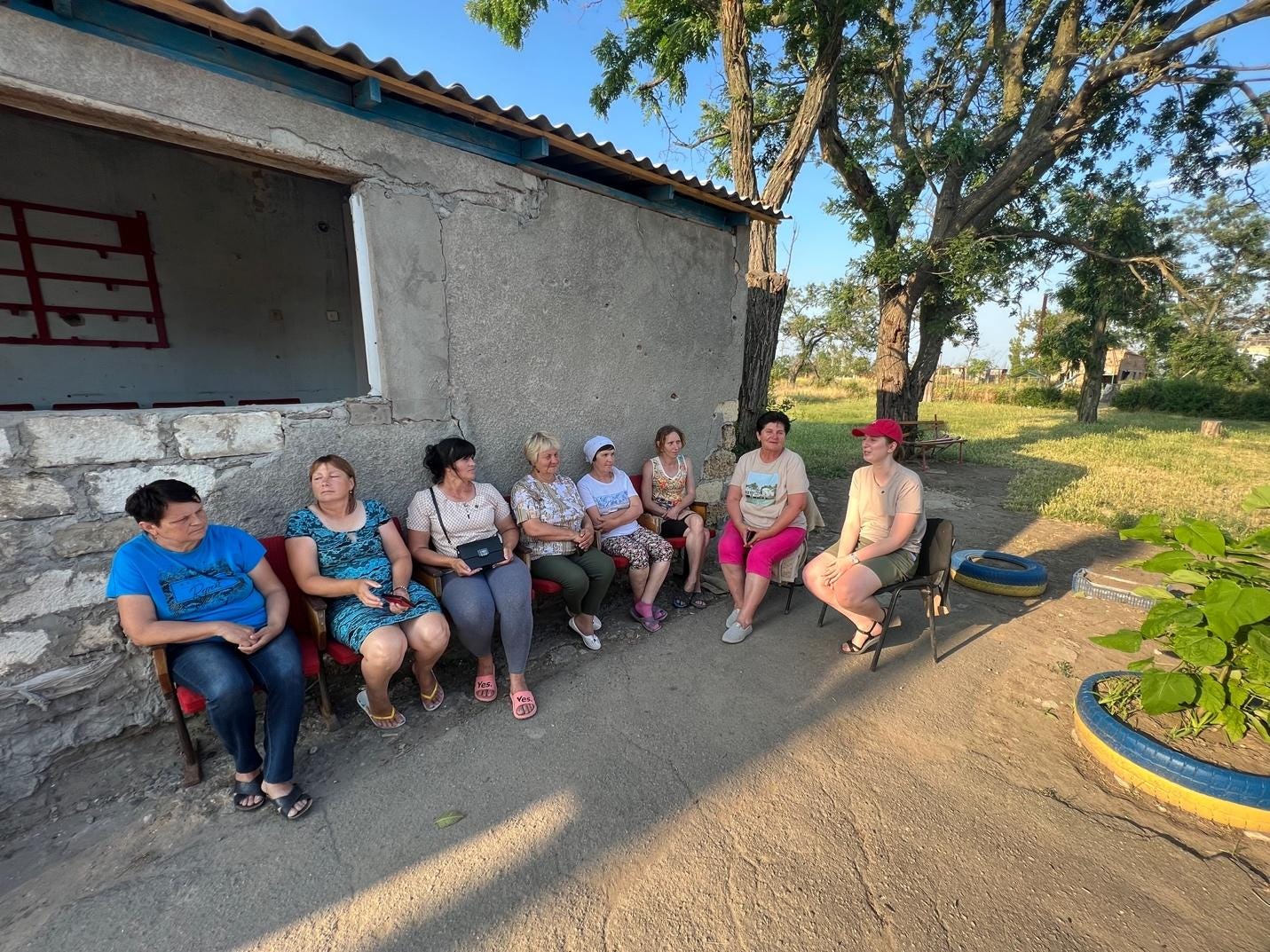
This incredible group of women spent over an hour with us to tell us their stories one by one.
We’ve come here to deliver approximately 450 kg of pet food, the storage and delivery of which is being funded by VWB/VSF, to support a burgeoning population of owned and un-owned dogs, puppies, cats and kittens. Just as importantly, we’re here to talk to village leaders and residents about their companion and livestock animals, their animal-related needs, and to talk about veterinary care. My job here is to simply learn, observe, ask questions, document, and pitch in where I can. I want to understand their challenges, listen to their stories, and hear from the people themselves what they need and what their plans are for themselves. I don’t arrive with any preconceived notion of how to do that, just a healthy curiosity, respect and patience. My translator and partner for the day, Kate, is a business development manager at an IT company in Mykolaiv, a volunteer for this mission, on loan from our local partner Phoenix. We are met at the town office by around eight women and one man. This small building, like nearly all others, is heavily damaged. The roof has been blown off along with half the outer wall. All the windows are gone. It’s still one of the best structures around though and is the focal point of the community. Everyone helps us to unload the pet food. We all chat for a bit, then we ask if anyone is willing to tell their stories, not expecting more than one or two volunteers, if any. It becomes clear that everyone is willing. We are gentle in our approach, clear about what our goals are and how we will use images and video to tell their story and craft our approach to find ways to support victims of this conflict.
I don’t provide any input on how we want to structure the interviews, mostly because I just want to see what happens and how they evolve organically. I also know that I couldn’t be much more of an outsider here. I’m not Ukrainian, I don’t speak Ukrainian, and I cannot relate to what they’ve been through. I don’t want to pressure anyone, much less exploit them. I’m bound by international humanitarian standards as much as by my own expectations of myself and I want to get this right. This matters a lot to me and my organization and I adopt the status of fly on the wall.
Kate is brilliant at her task. I don’t think I would have conceived of interviewing everyone together as a group, but that is exactly what happens. They all settle into mostly worn and crumbling old theatre chairs and slowly, one by one, they begin to tell their stories. I know what’s coming and brace myself mentally by taking in the beauty that does in fact exist around me: birds jumping around the branches of a tree over a small bench. The intense green of the whole countryside. The smiles everyone still has from time to time, despite what we all know is lurking beneath the surface. The evident signs of steps toward recovery. Then the stories start to flow, and with them, tears. I think everyone cried at some point, but that’s just a reminder that talking, when ready, is such an important part of processing grief.
Their stories are remarkable and tragic, reflections of strength they may not have known they had, and no doubt wish they didn’t need. A husband killed in a rocket attack. A grandmother raising her grandchildren because both parents have gone to fight. In fact, there are very few men in the village, none of whom are of military age or fitness. Women carry a disproportionate proportion of work and responsibilities in most societies globally, and the same is very true here. Everyone tells us of when the attacks began and of the intensity that finally compelled them to leave everything behind, not knowing if they would ever return or have anything to return to. Most everyone left in such a hurry under constant shelling that their farm animals had to be let loose, most never to be seen again. A woman tells of her son who loved pigeons and had dozens, all with names, before the war. When they were finally allowed to return, they managed to find a couple, in a rare and beautiful instance of reunification.
Many people who returned found at minimum no power, water, or windows. In many cases they were missing roofs, walls, doors, farm implements, or often, virtually everything. Several people are now living in semi-rigid tents provided by sheltering NGOs. Around half of the resident families have returned to rebuild. Still, somehow, they speak gratefully for the progress they’ve made in recovery so far and optimistically for the future.
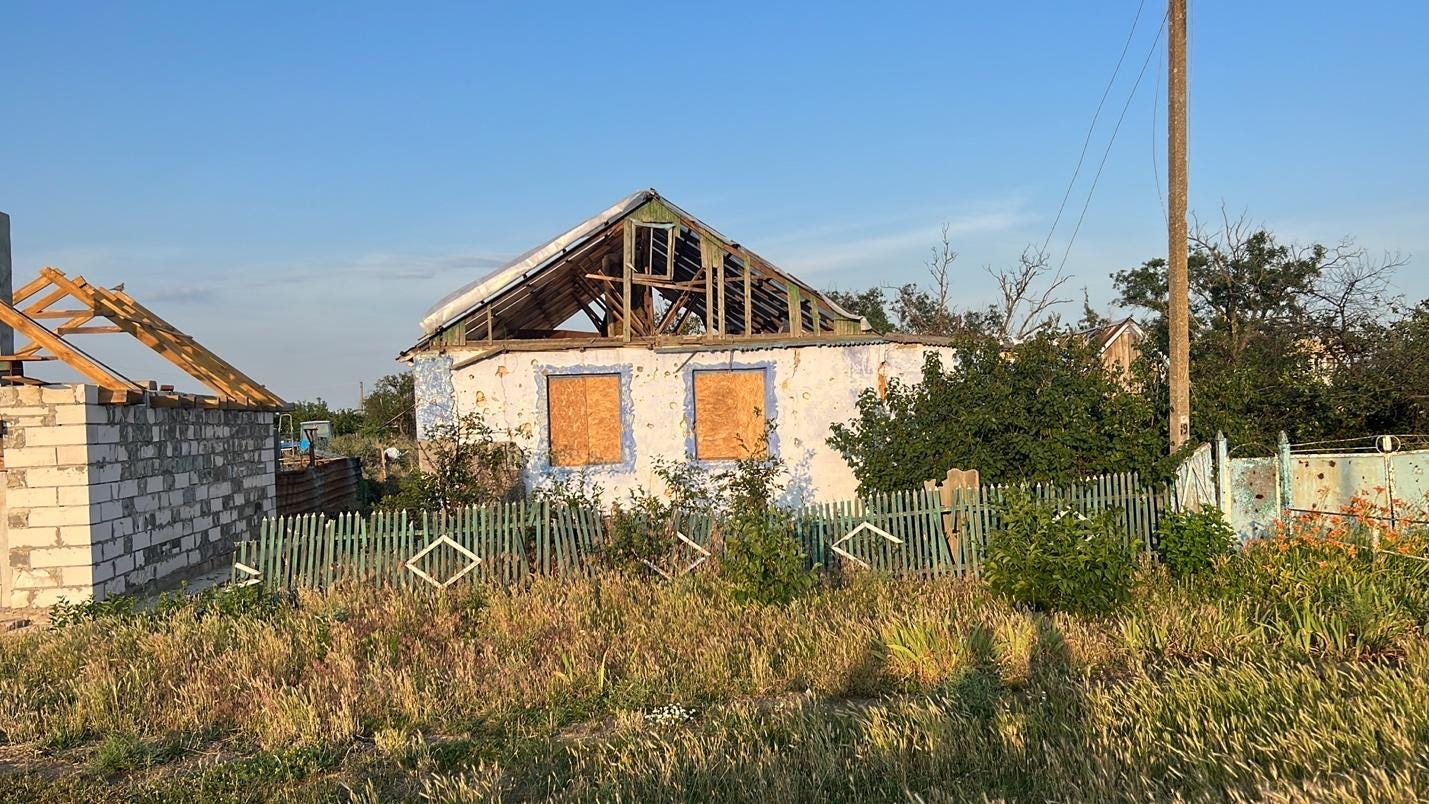
This is a typical village house with typical damage patterns.
Everyone seems particularly grateful that someone is talking to them about their farm animal needs. Between them all, we hear stories of chickens, ducks, rabbits, goats, pigs, and cows. They tell us how they cared for these animals and how they relied upon them. Some combination of these have been the primary source of livelihood for most people here, covering their subsistence needs and bringing in income. Animals have long been the backbone of this rural economy.
After the interview, the woman who lost her husband last March, happily takes us to her home to show us the progress they’ve made. A teenaged grandson and two older men are working on framing in a door, and new windows have been put in. There are blast craters in the back yard, and she shows us where her chickens, rabbits, ducks, and cows used to live. All of the structures are destroyed, but this doesn’t stop her from excitedly introducing us to her new broods of ducks and chickens, all foraging happily in makeshift pens constructed of scraps. I kneel to take some photos of the ducks and discover three-week old kittens in the neighbouring yard and a one-month-old puppy. I’m able to enjoy these curious, beautiful young lives for a few minutes, but inside my mind is racing to try to find ways to help this village and so many like it. The kittens and puppy need food to help their bodies grow, preventatives and vaccines to keep them healthy, spay and neuter surgery to keep from breeding beyond what the small community can support. The ducks and chickens need supplemental feed and safe, adequate housing. All the animals need routine and occasionally emergency veterinary care or consultation. And looming large, never far from any minds in Ukraine, winter will be here soon enough and with so many fields yet to be de-mined, most animals will need supplemental feeding to survive.
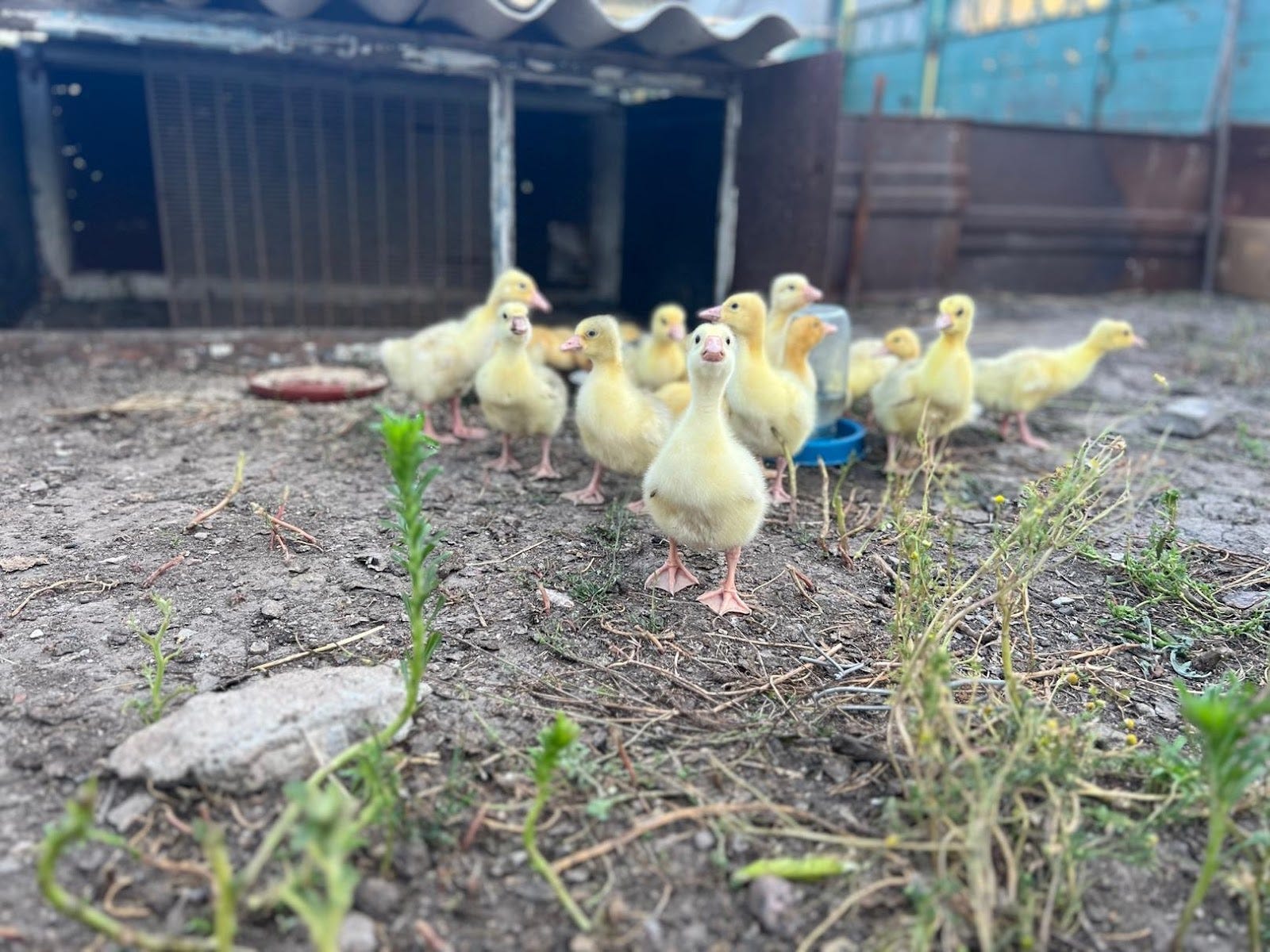
A new brood of ducks eyes me curiously. These ducks represent hope and dignity for their owner.
The challenges in Partyzans’ke are daunting. However, the needs there are put into further context four days later when I meet with a Ukrainian humanitarian agency in Odessa. They explain that for all its challenges, Partyzans’ke is actually quite a lucky community by comparison. It lies within easy reach of a mostly safe major city, along a road that has been de-mined and repaired and has been a frequent stop of many humanitarian groups because of these factors. There are many more villages that are farther, whose roads are barely passable, and who have had virtually no-demining take place.
Back on the train, I’m leaving Ukraine with what I think is an even stronger understanding of what the needs and challenges look like at a granular level. The scale can feel overwhelming at times. However, providing aid, veterinary services, and support for livelihoods are critical ways that Veterinarians Without Borders works to improve the lives of people and animals in places of crisis. Our goal is to attain lasting, positive impacts using a One Health model to develop programming that takes into account environment, animals, and humanity. In Ukraine, that has to-date meant traditional approaches such as provision of animal food, spay and neuter services, wellness services, support of local partner organizations, shelter support, and animal rescue as well as novel approaches such as virtual veterinary consultations and education for Ukrainian animal owners and professionals. Soon, we will begin to provide poultry, veterinary care, food, and animal housing repair to support small holder farmers.
Hearing the stories and seeing the circumstances in which victims of this war find themselves living is, for me at least, simply a reminder that if they can persist through such challenges then surely we can work together to help make a significant impact on their behalf.
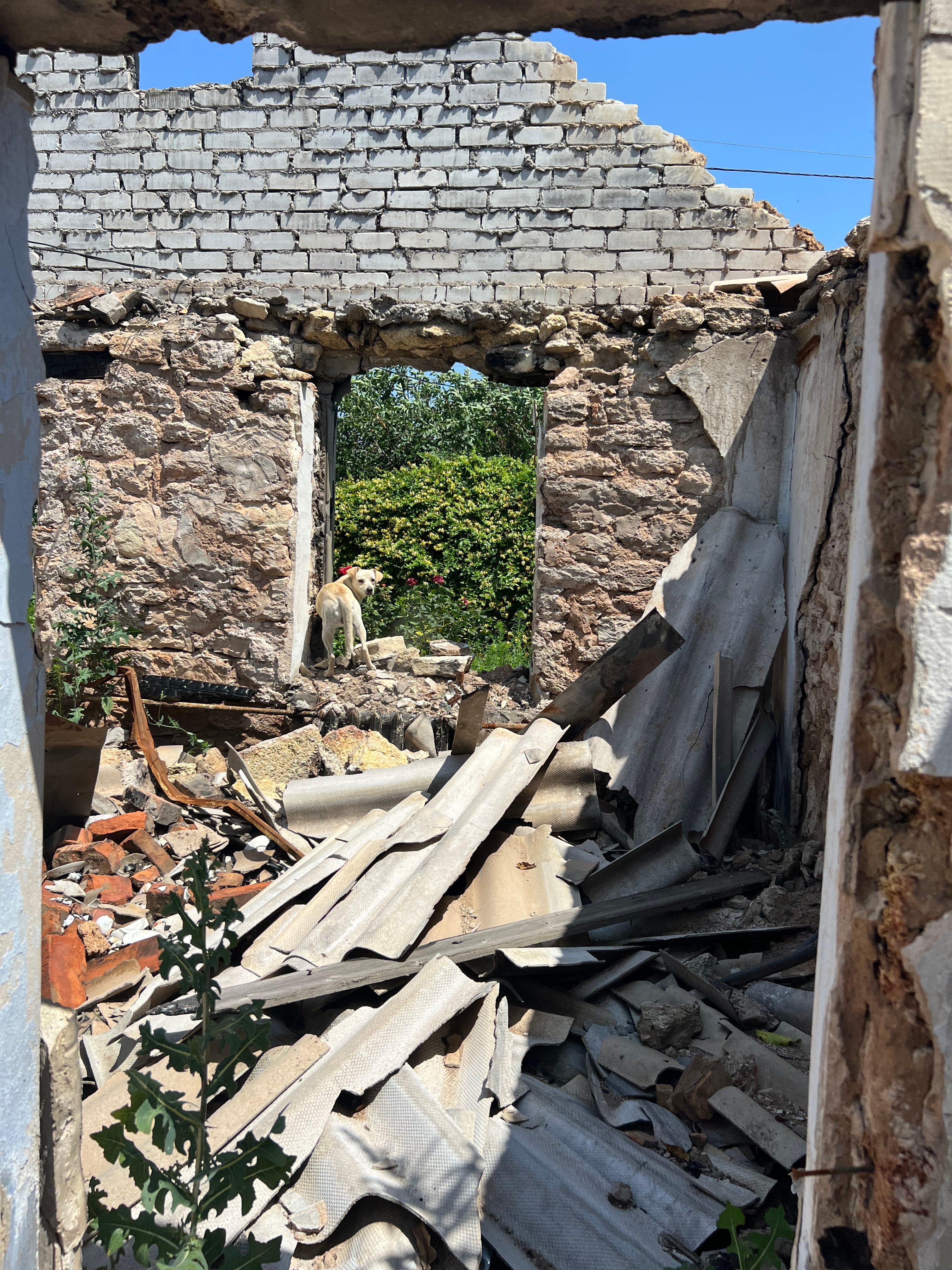
A village dog climbs out of the rubble to avoid me as I survey the ruins of a pensioner’s home.




